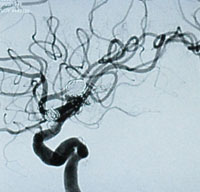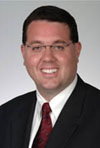|
|
|

|
Neuroangio Suite
marking pathway to
high-tech neurological care
|
by Dawn Brazell
Public Relations
Not having to stay at work until midnight has M. Imran Chaudry, M.D.,
smiling. So is the rest of MUSC’s cerebrovascular team. Members have
been waiting a couple of years to be able to use an expanded neuroangio
suite that will allow them to better handle the high volume of cases
MUSC is receiving.
 Dr. Aquilla Turk
sits in the control room where doctors use angio-based perfusion
imaging. Dr. Aquilla Turk
sits in the control room where doctors use angio-based perfusion
imaging.
Chaudry, a neurointerventional radiologist, sits in the control room
and pulls up angio-based perfusion imaging of a patient’s brain. The
patient, a recent success story, had been referred from another
hospital eight hours after her stroke. She had paralysis on her right
side, was experiencing difficulty in speaking and was outside the
accepted time period for conventional stroke treatment.
  These images were
taken during a recent coiling procedure, using a new device, to repair
and aneurysm. Visit http://www.youtube.com/watch?v=MJUiz3T4S_k These images were
taken during a recent coiling procedure, using a new device, to repair
and aneurysm. Visit http://www.youtube.com/watch?v=MJUiz3T4S_k
“The team was able
to quickly open a blocked middle cerebral artery using a novel
thrombectomy device, the penumbra aspiration system. She was able to
walk out of the hospital two days later — completely normal,” said
Chaudry.
It’s just one example of how this suite will be saving lives.
A ribbon cutting will be held at 2 p.m. Nov. 22 on the 3rd floor of the
university hospital in radiology to celebrate the opening of the suite.
Expanding the existing facilities from 1,450 to 3,450 square feet, the
suite features a procedure room with a shared control room between
the two procedure areas. The almost $2.5 million renovation includes a
Siemens Artis Zee biplane unit, which offers advanced 3-D imaging.
Raymond Turner, M.D., director of the Comprehensive Stroke and
Cerebrovascular Center, Department of Neurosurgery, said the expansion
will allow the team to better handle its caseload, particularly as
MUSC’s reputation in handling stroke and cerebrovascular disease has
grown.
Historically, South Carolina has had the worst track record in the
country for stroke outcomes, he said. The stroke belt is a region of
the Southeast that has a high prevalence of stroke and cerebrovascular
disease.
“South Carolina is in the heart of the stroke belt. We’re the buckle of
the stroke belt,” he said. “As the No. 1 cause of disability in the
U.S. and number three cause of death, stroke is a devastating disease.”
The past three years, MUSC has responded to this problem by investing
millions in recruiting world-renowned physicians in stroke neurology,
neurointerventional radiology and endovascular neurosurgery, he said.
The suite underwent an upgrade, which also resulted in an increase in
the volume of stroke patients being treated.
“Fortunately, it also has resulted in outstanding results in patient
care that is setting a new benchmark for clinical outcomes. Over
the past three years, we have moved MUSC from relative obscurity in
stroke care to a program that is on a very short list as being one the
busiest and best programs in the country. It is because of this
massive increase in volume, that the second room is needed.”
 Dr. Raymond Turner Dr. Raymond Turner
Turner said they are asked to present at conferences on why MUSC’s
approach works so well. One part of the equation is the world-class
specialists the hospital has in stroke neurology, neurocritical care,
neurointerventional radiology and endovascular neurosurgery. They also
have an innovative telemedicine program with outreach to rural areas
lacking such specialists. Couple that with an administration willing to
invest in the latest technology, and MUSC has one of the finest centers
in the nation, he said.
“Having two, state-of-the-art neurovascular angio suites means no
patient has to wait — and when 1.9 million neurons die every minute
during a stroke — every minute, every second counts. It
also means these patients have access to a level of care that is
unprecedented — from multicenter clinical trials that are run out of
MUSC to novel devices that are not available at most centers in the
country.”
The latest example of this is MUSC’s research partnership with SUNY —
Stony Brook and Siemens, where MUSC is validating the perfusion
technology that is based on angiography.
“We already have the ability to acquire CAT scan imaging from our angio
suite without taking the patient to a CT scanner, but we also can now
look at the blood flow to see if the brain cells are getting enough
blood to allow them to recover or not. This is critical for a patient
who is having a stroke. Everything we do is based on the presumption of
a survivable brain — we’re working on a technology that will give us
that answer in real time.”
Friday, Nov. 19, 2010
|
|
|






